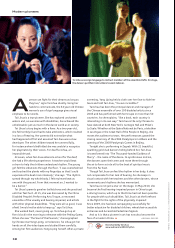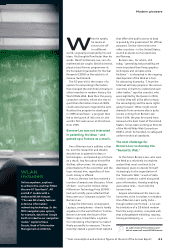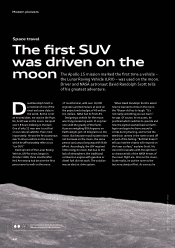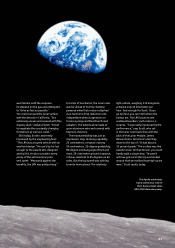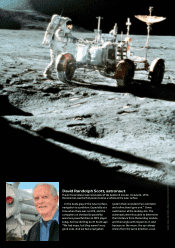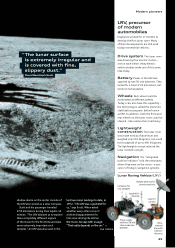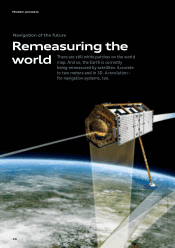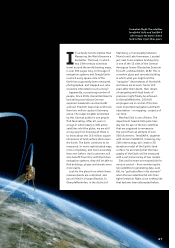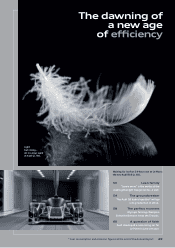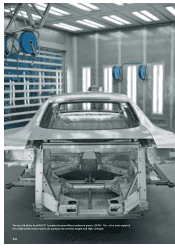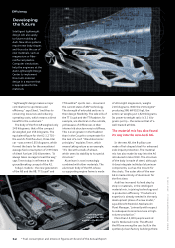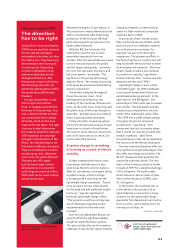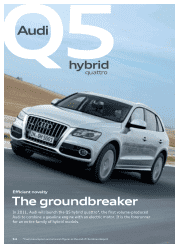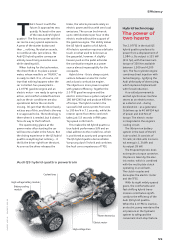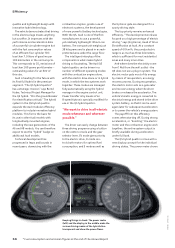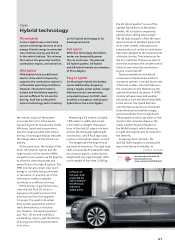Audi 2010 Annual Report Download - page 50
Download and view the complete annual report
Please find page 50 of the 2010 Audi annual report below. You can navigate through the pages in the report by either clicking on the pages listed below, or by using the keyword search tool below to find specific information within the annual report.
48
“Neither satellite knows the
other exists, so to speak.
And that makes it especially
diffi cult to coordinate the
two radar systems precisely
and keep them synchronized,”
explains Zink. The data from
space is scheduled to arrive
at DLR in Oberpfaff enhofen
by 2013. It will provide
enough information to fi ll
200,000 DVDs.
A few buildings away is the
main headquarters for the second
project that could revolutionize navi-
gation. Called Galileo, it is a European
Community program involving 30
operative satellites, which will at one
point begin transmitting navigation
signals to three frequencies. This will
make it possible, for example, to locate
every position to within an accuracy of
three meters. With its 24 satellites,
the GPS system commonly used today
is only half as accurate.
The DLR Gesellschaft für Raumfahrt-
anwendungen (GfR) mbH, a DLR e.V.
company, is headquartered in the
Galileo Control Center. Its main job
is to prepare and operate Galileo.
Christian Arbinger heads Operation
Services at the Control Center in
Oberpfaff enhofen. Like his colleague
Zink, he currently tracks the status of
the Galileo satellites in simulations
and testing on the monitors in the
Control Center. Two test satellites are
already in orbit; the fi rst two satellites
for the future Galileo constellation are
scheduled to launch soon. According
to plans, 18 satellites will broadcast
the fi rst navigation services in 2014.
After that, Galileo will be expanded
to its full scope of 30 satellites.
Arbinger is proud of his project. It
will take 100 scientists to control all
of the satellites. “Galileo may be the
third global navigation system after
the American GPS and the Russian
GLONASS,” says Arbinger, “but it’s the
fi rst civilian system of this kind, and is,
in a sense, Europe’s fl agship project.”
And one that will open up new
possibilities for navigation systems
of the future. They will be capable of
processing signals from both GPS
and Galileo, meaning they will have
more than 50 navigation satellites
at their disposal. That is important
for eliminating blackouts caused
by a failure to receive signals from
space, a regular occurrence today in
urban canyons.
The future 3D elevation models
and the Galileo satellites will also be
a boon for the navigation systems
in Audi cars. “We will be able to tell
with even greater accuracy when a
street becomes steeper or slopes
off ,” says Dr. Stephan Reitzner, Team
Coordinator for Navigation Systems
at Audi. This will make it possible to
lower fuel consumption and increase
a car’s range, he adds. “With accurate
elevation data, we will also be able
to improve transmission settings on
cars and calculate economical routes.”
Economical routes are very important
for electric cars in particular, as every
recharging stop is a time-consuming
matter. “Thus it might be possible to
make a round trip on a single battery
charge,” says Dr. Reitzner.
He and his team also use a backup
system, which is currently showing its
strengths in cities like New York and
Chicago, where the average building
is 40 stories high. Thanks to a number
of additional sensors, Audi navigation
systems do not lose their bearings,
even if they lose contact with the
GPS for an extended period. “The car
navigates virtually on its own,” says
Dr. Reitzner. Humboldt and Gauss
would certainly have been pleased.
OLIVER RICHARDT
Modern pioneers
The new Audi
navigation system plus
The image – here a detail map of Venice –
is based on data from Google Earth.
Buildings, plazas and streets are even
easier to recognize than before.
The control center in Oberpfaff enhofen:
The Galileo system’s satellites will be
controlled from this modern glass and
concrete building in the future.
PHOTOS | GERMAN REMOTE SENSING DATA CENTER OF THE DLR; AUDI AG (2); ISTOCKPHOTO.COM
Find out more about the
navigation of the future at:
www.audi.com/ar2010/navigation
O
“Neither satellite
other exists, so t
o
A
nd that makes it
d
ifficult to coordi
n
t
wo radar system
s
a
nd keep them sy
n
e
xplains Zink. The
s
pace is schedule
d
a
t DLR in Oberpfa
ff
b
y 2013. It will pr
o
e
nough informati
o
2
00,000 DVDs.
A few buildings a
w
d
quarters for the
project that could revoluti
o
gation. Called Galileo, it is
a
Community program invol
v
operative satellites, which
w
point begin transmitting na
The new Audi
navigation system plus
The image – here a detail map of Venice –
is based on data from Google Earth.
A
d
t
a
e
s
a
b
e
2
main hea
d


